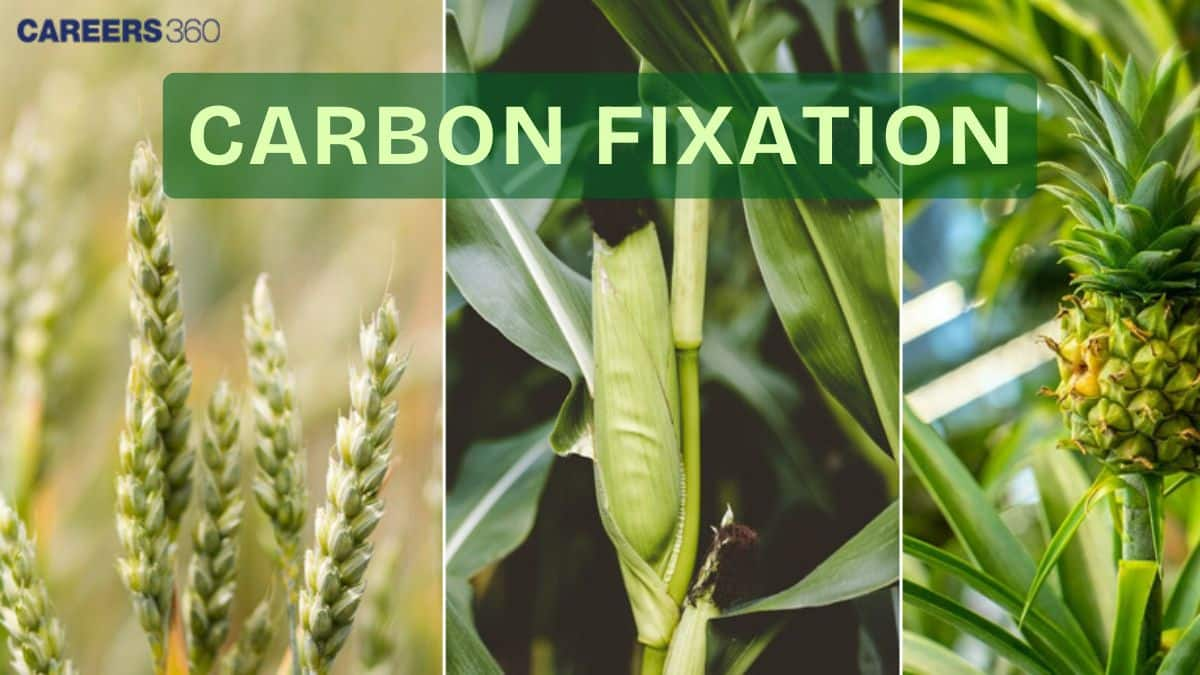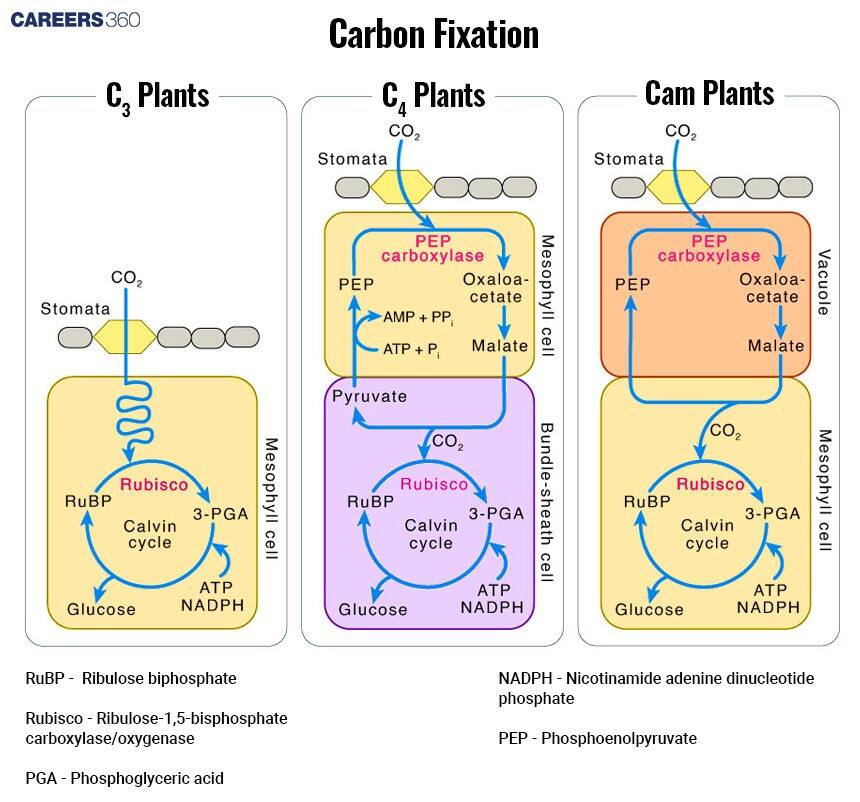Carbon Fixation: Meaning, Process In C3 C4 And CAM: Process In C3 C4 And CAM Plants
Carbon fixation is the process by which plants, algae, and some bacteria convert atmospheric CO₂ into organic compounds like sugars using the Calvin Cycle and related pathways. It forms the foundation of life’s carbon flow, driving photosynthesis and ecosystem productivity. Different plants — C₃, C₄, and CAM — use specialized mechanisms to optimize carbon fixation under varying environmental conditions.
This Story also Contains
- What Is Carbon Fixation?
- Mechanism Of Carbon Fixation
- Carbon Fixation In C3 Plants (Calvin Cycle Pathway)
- Carbon Fixation In C4 Plants (Hatch–Slack Pathway)
- Carbon Fixation In CAM Plants (Crassulacean Acid Metabolism)
- Comparison of Carbon Fixation in C3, C4, and CAM Plants
- Significance Of Carbon Fixation
- Carbon Fixation NEET MCQs (With Answers & Explanations)

What Is Carbon Fixation?
Carbon fixation is defined as the biochemical process through which plants, algae, and certain bacteria convert atmospheric carbon into organic compounds. This process is crucial for the survival of autotrophic organisms and forms the foundation for the energy supply in ecosystems.
Mechanism Of Carbon Fixation
Photosynthesis is the primary mechanism for carbon fixation. This process occurs during the light-independent reactions, commonly known as the dark reactions, of photosynthesis. While the fundamental pathway for carbon fixation is the Calvin Cycle (C3 pathway), the process varies slightly among C3, C4, and CAM plants.
Carbon Fixation In C3 Plants (Calvin Cycle Pathway)
In C3 plants, carbon fixation occurs through the Calvin cycle, which is the main pathway for carbon fixation across various plant types.
Key features of carbon fixation in C3 plants include:
Location: The Calvin Cycle occurs in the stroma of chloroplasts.
First Product: The initial product of carbon dioxide fixation is a 3-carbon compound known as 3-phosphoglyceric acid (PGA).
CO2 Acceptor: The five-carbon compound ribulose bisphosphate (RuBP) serves as the CO2 acceptor.
The Calvin Cycle consists of three main stages:
Step | Description |
Carboxylation | In this step, carbon dioxide is fixed by RuBP carboxylase / oxygenase (RuBisCO), leading to the formation of PGA. |
Reduction | ATP and NADPH produced during the light-dependent reactions are utilized to convert PGA into glyceraldehyde-3-phosphate (G3P), a simple sugar. |
Regeneration | Some G3P molecules are used to regenerate RuBP, ensuring the cycle continues. To produce one glucose molecule, six cycles are needed, consuming a total of 6 CO2, 18 ATP, and 12 NADPH. |
Carbon Fixation In C4 Plants (Hatch–Slack Pathway)
In C4 plants, carbon fixation is adapted to enhance efficiency in hot and dry environments. The process involves several distinct features:
First Product: The initial product of carbon fixation is a 4-carbon compound known as oxaloacetic acid (OAA), contrasting with the 3-carbon PGA produced in C3 plants.
CO2 Acceptor: In C4 plants, phosphoenolpyruvate (PEP), a 3-carbon compound, acts as the CO2 acceptor.
Location: Carbon fixation occurs in the mesophyll cells, while the Calvin Cycle takes place in the bundle sheath cells.
The C4 pathway involves the following steps:
Step | Description |
Carboxylation | PEP carboxylase catalyzes the reaction between PEP and carbon dioxide, forming OAA. |
Conversion | OAA is converted into other 4-carbon acids such as malic acid and aspartic acid, which are then transported to the bundle sheath cells. |
Decarboxylation | In the bundle sheath cells, malic acid is decarboxylated to release carbon dioxide, which enters the Calvin Cycle. The remaining 3-carbon compound is returned to the mesophyll cells for regeneration of PEP. |
Carbon Fixation In CAM Plants (Crassulacean Acid Metabolism)
The CAM (Crassulacean Acid Metabolism) pathway is a unique adaptation found in plants that inhabit arid environments, such as cacti. Key characteristics of carbon fixation in CAM plants include:
Step | Description |
Night Time Fixation | CAM plants fix carbon dioxide during the night when stomata are open, allowing for CO2 uptake without excessive water loss. |
Storage of Malate | The fixed carbon is converted into malic acid (a 4-carbon compound) and stored in vacuoles overnight |
Day Time Utilisation | During the day, malic acid is transported to chloroplasts, where it is converted back into carbon dioxide for use in the Calvin Cycle. returned to the mesophyll cells for regeneration of PEP. |
Comparison of Carbon Fixation in C3, C4, and CAM Plants
The difference between C3, C4 and CAM plants is:
Feature | C3 Plants | C4 Plants | CAM Plants |
First product | 3-PGA (3C) | OAA (4C) | Malate (4C0 |
Enzyme | RuBisCo | PEP carboxylase | PEP carboxylase |
CO2 fixation site | Mesophyll | Mesophyll & bundle sheath | Mesophyll |
High | Negligible | Low | |
Adaptation | Cost, moist climate | Hot, sunny region | Arid regions |
Examples | Wheat, Rice | Maize, Sugarcane | Cactus, Agave |

Significance Of Carbon Fixation
The significance of carbon fixation in plants:
Supports the biosynthesis and the energy flow in the ecosystem.
Forms the basis of productivity in the biosphere.
Helps to develop plants with high-yield crops and optimize the assimilation of carbon dioxide for climate adaptations.
Carbon Fixation NEET MCQs (With Answers & Explanations)
Important topics for NEET are:
Mechanism of Carbon fixation
Carbon fixation in C3, C4 & CAM Plants
Practice Questions for NEET
Q1. The plant family that does not show CAM pathway is
Crassulaceae
Euphorbiaceae
Cactaceae
Gramineae
Correct answer: 4) Gramineae
Explanation:
CAMs are the most adapted xerophytic conditions, with plants from the Crassulaceae, Euphorbiaceae, and Cactaceae families. The stomata of these plants open at night, and the carbon dioxide absorbed is fixed by them in the form of malic acid within the vacuoles. At daytime, the fixed carbon is released and utilized for the C3 cycle, along with photosynthesis. Thus, CAM plants conserve water in arid conditions and can survive in such habitats.
Hence, the correct answer is option 4) Gramineae.
Q2. CAM helps the plants in:
Conserving water
Secondary growth
Disease resistance
Reproduction
Correct answer: 1) Conserving water
Explanation:
Crassulacean acid metabolism (CAM cycle) -nIn this pathway, stomata open at night to reduce transpiration and fix CO2 to malic acid which gets stored in vacuoles.nCAM plants are succulents in the habit and have the slowest photosynthetic rate.
Hence, the correct answer is option 1) Conserving water.
Q3. The enzyme that converts oxaloacetate into malic acid is
Malate dehydrogenase
Oxalophosphatase
Malic phosphatase
RuBP carboxylase
Correct answer: 1) Malate dehydrogenase
Explanation:
Malate dehydrogenase is the enzyme that changes oxaloacetate into malic acid.
Using NADH as a cofactor- malate dehydrogenase catalyzes the conversion of oxaloacetate to malate. Malate is an intermediary that aids in the synthesis of glucose and the creation of energy in the citric acid cycle (also known as the Krebs cycle) and gluconeogenesis, both of which depend on this process.
Hence, the correct answer is option 1)Malate dehydrogenase.
Also Read:
Frequently Asked Questions (FAQs)
Carbon fixation occurs in the dark reactions of photosynthesis, which do not require light directly but depend on the products of light reactions.
The enzyme RuBisCO (ribulose-1,5-bisphosphate carboxylase/oxygenase) catalyzes the carboxylation of RuBP, initiating the carbon fixation process.
Carbon fixation primarily occurs during photosynthesis, utilizing ATP and NADPH to convert carbon dioxide into carbohydrates.
The Calvin Cycle is the main biosynthetic pathway for carbon fixation, converting CO2 into sugars using ATP and NADPH generated during light reactions.
Besides the Calvin Cycle, other pathways include the reductive citric acid cycle and the 3-hydroxypropionate cycle, which occur in certain bacteria and archaea.
The three stages are carboxylation, reduction, and regeneration, each playing a crucial role in fixing carbon and producing glucose.